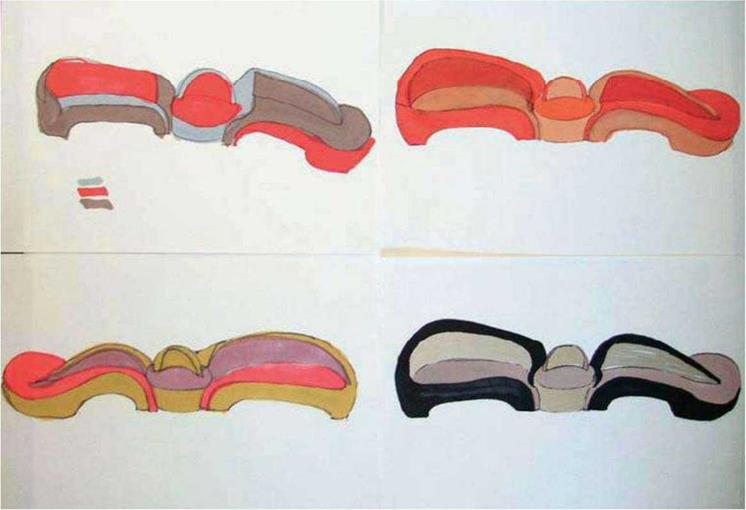With the Comet Sofa, Kagan continues his decades-long tradition of creating sensuous sofas that sit in the middle of a room and allow for a wide range of seating configurations. “These free-form designs have been the driving force of my designs,” he says. “I like to make something that can be moved, rearranged, and allows you to sit in different directions.” The Comet began when Roche Bobois came to Kagan looking for designs that reflected his quintessential design vernacular. “I went to visit them in their Washington, D. C. store,” Kagan recalls. “I brought along a whole suitcase of designs, but all of a sudden, I was inspired and I started to sketch on the train. It just hit right,” he says. “I do well sketching under abnormal circumstances. I work on airplanes, on the corner of a table in somebody’s house—the inspiration hits that way.” He says, “I’m a doodler. I was doodling. I always travel with a roll of tracing paper, so I start drawing at one end and keep going to the other.”
The charge was to make a sofa that had the “Kagan” aesthetic written all over it, but to also make the piece modular so its configuration and colors can be customized by the end user. “We came up with this idea of a free-flowing sofa, with a central axis of a chair, and two free-form sofas at either end,” says Kagan. “You can add or subtract color and make it very personal that way. You can customize the piece of furniture.” He points out, “Manufacturers do not want to have a lot of frames and product on a shelf that makes up a collection. This collection has only three SKUs, and they love that. They don’t need to carry a lot of different inventory. You have left and rights and you can drop off the back of the chair so it becomes a pouf. The whole thing is very flexible, yet with a very limited number of elements. The way the furniture pivots around the center round chair, you can open it up and make it a straight sofa or make it very tight and fit in a corner. You can have half in one direction and one in another. It can be ordered without a back, and then it would be a huge, open pouf that would give you seating in all directions.”
Kagan adds, “The serpentine sofa comes from the late 1940s. Every manufacturer wants to license that product, so I have to think how can I give them something like that.” For the Comet, Kagan says, “I worked with the serpentine concept and tried to bring it into the twenty-first century.”
The Comet is made of layers of differing density foam over wooden frames. Roche-Bobois offers it with removable slipcovers in a wide range of fabric choices. “People enjoy it because you can play with it,” says Kagan. “You could do it monochromatic or in quite contrasting colors. It becomes very personal, which is great, because color is very subjective and color is what identifies people.”
|
140 DESIGN SECRETS: FURNITURE |
|

 0 Above left: Clay models show the three component parts of a central chair with a sofa that extends off either end like the tail of a comet, hence the name. Credit: Vladimir Kagan
0 Above left: Clay models show the three component parts of a central chair with a sofa that extends off either end like the tail of a comet, hence the name. Credit: Vladimir Kagan
{/ ) Kagan was prepared to show the manufacturer, Roche-Bobois, several design options, but on the train ride to the meeting, began sketching a new idea, which turned into the Comet. Credit: Vladimir Kagan
® When all three parts are used together, the Comet becomes a huge piece, almost 13′ (4 m) feet in length. The pieces can be ordered without backs, so people can sit facing any direction. Credit: Vladimir Kagan
® The Comet is available in a wide range of fabric choices and is made with removable slipcovers over each piece, which allows customers to personalize the sofa. Credit: Vladimir Kagan

|
Opposite top: The generous proportions, inviting shape, and multi-dimensionality of the Comet become fully realized in this full-scale prototype.
Credit: Vladimir Kagan
 |
 |
Opposite bottom: The Comet can be ordered in monochromatic tones, but choosing different colors for each section and component part plays up the sensual lines as well as the piece’s modularity. Credit: Michel Gibert
|
|
|
|






